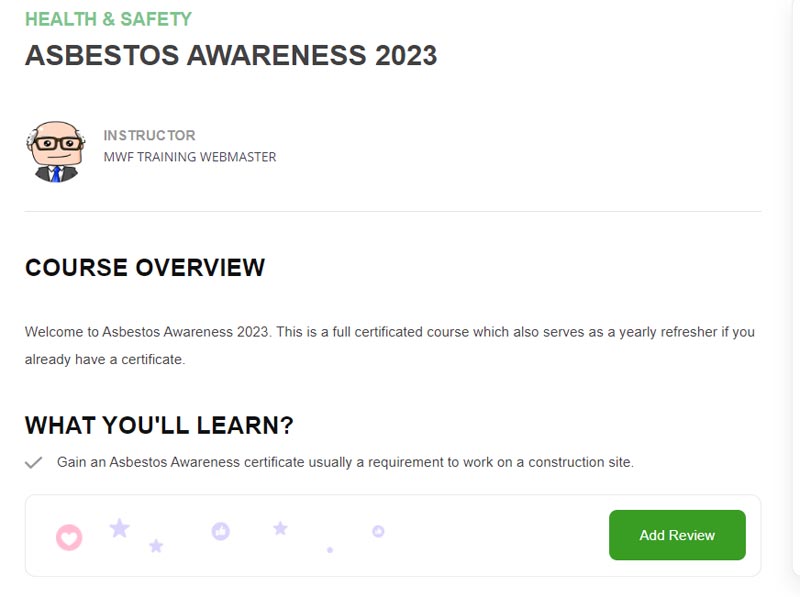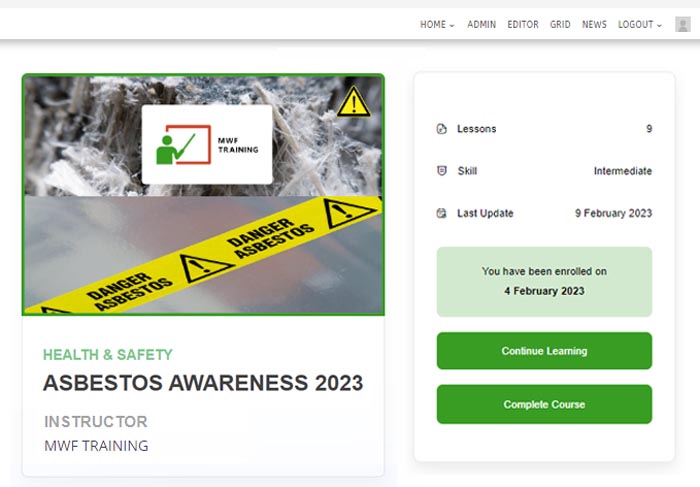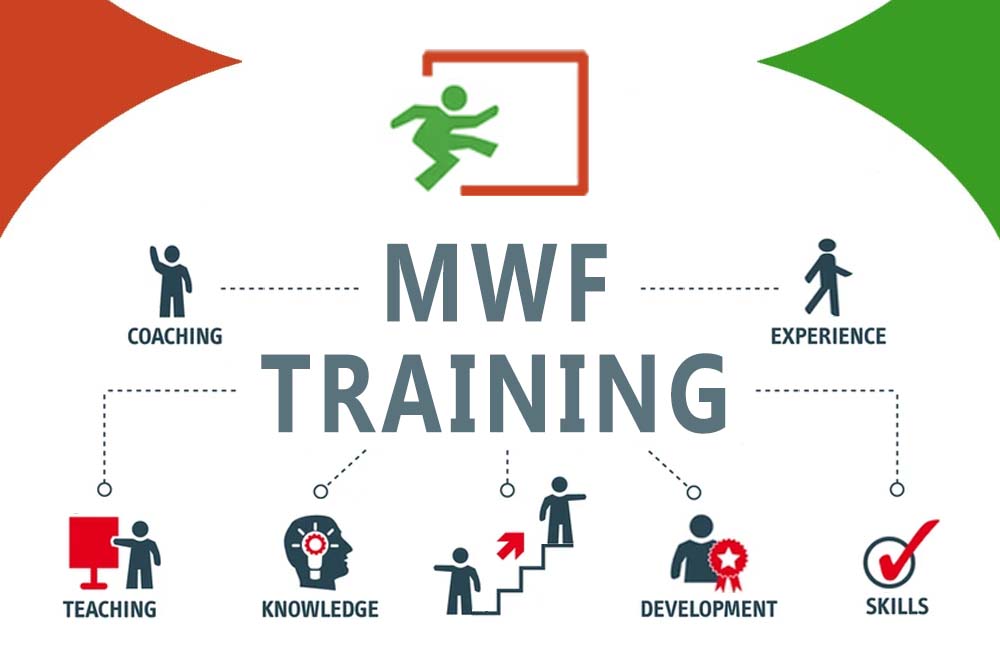MWF Training takes off in style
There is a handful set of training modules that encompass the broad spectrum of health and safety protection in the workplace which include manual handling, first aid, working at height with the most important of these being asbestos awareness.
This is because an asbestos survey is the first thing to sort out before any work can begin on a new project and remains relevant throughout the project. It is the only certificated training often asked for by a Principal Contractor, aside from the H&S requirements that are part of obtaining a skillscard.
Unsurprisingly, many organisations offer quick and cheap training solutions. The certificates are often plain looking and un-professional which is a warning sign that not much thought went in to the course. When you achieve something great, you want your certificate of achievement to do it justice, perhaps your name is written in gold leaf and it’s been authorised by the King of England. As this detail is not really appreciated, the trainee is left feeling a little deflated when their download arrives.
In the sea of competition, courses that carry a RoSPA or CPD logo are often the better and cheaper option; £15 for a RoSPA asbestos awareness course compared to the standard £25 from other providers. This notion of a seal of approval from recognisable organisations holds well with professional training, such as CiTB backed SSSTS certification but a gap in the market has arisen for awareness courses that fall between tootlbox talks and professional training.
This extends to the safe use of stepladders and ladders, working with chemicals (COSHH), working at height, manual handling, and much more site specific training. It transgresses to the office environment where anything is game; office lighting, posture, VDU awareness as well as the site courses that are applicable in an office environment too, such as working with chemicals (COSHH) and manual handling.
The objective of an asbestos awareness course is to educate on the material and to train to recognise and deal with it, if it is encountered in the workplace. This should be the first tier in establishing the foundation for a safe working environment. At its heart is the risk assessment philosophy of Eliminate and Reduce, to lower the risk.
It’s somewhat surprising then, that this worthy effort has become trivialised. There are no rules for the provider and anyone can design and offer awareness training. In this new field of off-the-shelf qualifications the established organisations that govern the professional and bona fide courses have clubbed together to capture some of that breakaway market. It is substantial and a similar analogy can be drawn from web designers that ignored mobile phone users until they were forced to listen; as of February 2023, 60.04% of all website traffic on the internet comes from mobile devices.
It’s all about capturing your custom of course, because it’s become clear that the material is second rate and probably the mystifying thing is why would established providers align themselves with this significant drop in quality – well, the answer is money again. In this enterprise the organisations that are involved in training and business documentation, certification and accreditation, have clubbed together.
For example, MW Fire are members of SMAS, an SSIP organisation that give their seal of approval to a company’s documentation which is regularly requested by the client, such as Principal Contractors and Building Services. This is typically for maintaining policy documents and training records. These clients ask for yearly updates and it is the sole reason why SSIP is relevant in the business world.
If you are at the SMAS website seeking advice on approved training, you will be linked to the HS Direct website. We’re not sure what the relationship is here, but HS Direct have emerged as a major online basic and intermediate online training provider in part due to this type of association with SMAS.
Having completed a flash course with HS Direct, you can immediately download your certificate. This certificate is now used by a company to send to SMAS. So there exists a collaborative in-house cycle that has been established to capture a share of the basic awareness training market.
The HS Direct courses are fully automated and can be completed in around fifteen minutes. Certificates have the CDP Certification logo which aims to add credibility to this computer generated digital download which is supposed to validate your astounding achievement. Instead it serves only to belittle the efforts of real training providers that go out in the field to provide real training. Why would you want to pay £160 for someone to come out and train you to use a stepladder when you can download a certificate in 15 minutes for £15.
The truth is that a company doesn’t need to use an SSIP and could easily manage its own documentation. In the same vein companies could also arrange for their own operative training and so by-pass the need for trainers and SSIP entirely. It really is a matter of horses for courses. Ultimately the various parties all take their cut and the final cost is passed to the trainee or the company.
It is the SSIP bodies and the accreditation bodies like CPD that stipulate that training should be updated yearly, this is a lucrative repeat business stream. Asbestos training for example does not have an expiry date, certainly not from the HSE. But the Asbestos ACOP suggests, rightly so, that the knowledge should be refreshed at reasonable intervals which the validation organisations interpret as yearly.
Is it any wonder that construction workers feel that the system is geared to squeezing as much out of them as possible. Yet for them, training has become just more paperwork than you need to have in order to progress. This doesn’t necessarily mean they need to prove they know about working at height, for example, only that they have a downloaded certificate that says they have been approved to work at height.
The reality is that these courses may have been compiled by people with no construction or site experience and it could well be that clerks have written the material to populate the application software. In many cases this has turned the training in to a sham. It’s not just a UK problem but extends to the US where First Aid training is produced, endorsed and certified by popup organisations without any hands on experience. This happens even though the governing body OSHA hold the view that online training alone does not meet their First Aid training requirements.
One popular training provider was contacted by MW Fire to enquire about their asbestos course (research for our own course). The presentation was poor and contained several typos. It comprised of 20 slides, each about the size of a quarter of a Powerpoint presentation page, so in all that’s equivalent to 20 / 4 = 5 pages with a test of 5 easy questions. On completion of the test the unremarkable certificate was immediate available to download. The provider in this instance showed no interest over our concerns regarding the poor quality of their material.
To whom should the professional accountability for the quality of the training fall upon? Is it enough to deliver five pages which the CPD will rubber stamp as ‘verified’ training? Who exactly is doing the stamping anyway. It’s a practice that is catering for trainees that don’t value the knowledge but just need the endorsement of a digital document for them to appear to be more qualified onsite than they actually are.
MW Fire monitors the training of all operatives; employees and subcontractors. It’s not unheard of to see four or five workplace certificates from the same provider awarded on the same date. The first thing you might be thinking is how does one truly learn several topics in one day. If you ask that person to discuss their training it’s debatable whether they are knowledgeable enough to indulge you. It sheds light on the poor quality of some of these online training courses and the ineffective manner in which awareness training is being disseminated.
For employees the training is managed best by using trusted providers but there is less control over subcontractors. If a subcontractor provides a certificate of working at height for example, what does this really mean? If they have an accident working at height that’s for them to deal with but in reality it reflects on the contractor and the client in terms of health and safety KPIs. Each level in the project share the responsibility in deciding overall on the competency of the workforce irrespective of the validity of the documentation that they have produced. A CPD logo on a digital certificate is great marketing for the CPD organisation but holds little value in ensuring workers are protected from asbestos related diseases.
To save costs site training has been contracted out en-masse. But it does not represent a saving in the long term. What’s the point of a highly certificated workforce that does not behave professionally in the workplace. MW Fire has decided to take a pro-active approach to the quality of its operatives by offering a large part of this training internally. Controlling the quality of training is an investment.
Employees and subcontractors working on or on behalf of MW Fire can register a website account and have access to the MWF Training dashboard. From here all available courses can be accessed and a record is kept of progress. The courses are not perfect by any stretch, but they have been designed by experienced operatives and are far superior in comparison to standard courses available elsewhere.
The courses in MWF Training are more in depth than standard courses with a more challenging test that requires a pass mark of 80%. Operatives are still allowed to seek external certification if they wish and we have found that some do prefer to pay for a course that saves them time to learn, compared to undertaking a free course that requires actual learning. We are not going to judge. But there’s no denying that there has been a significant uptake in the asbestos awareness course form office and operational staff alike and that it has been a massive success so far.
As new training becomes available it can be easily added to the dashboard. In some situations like for stepladder training, it can be supplement with onsite demonstration from the site supervisory staff. The trainee controls the speed at which they go through the material, there is no timeframe. A button is clicked to signify a completed lesson and also that the course has been completed. There is also a facility for questions and answers during the course.
Some thought too went in to the certificate design. We did not want it to look tacky or overly complicated but sufficiently appealing, especially when compared to standard certificates. In this endeavour we believe anyone would be proud to receive a training certificate of achievement from MWF Training.
We are at the beginning of MWF Training and it is really exciting to commit to this as a business asset. We hope that all operatives will appreciate the advantage of free and quality training and that it will evolve in to an essential part of the support provided to staff and engineers that are providing the front line fire services that MW Fire offer its customers.








